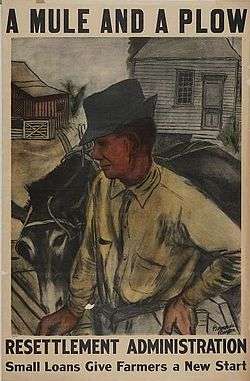Resettlement Administration
 Resettlement Administration poster by Bernarda Bryson Shahn. | |
| Agency overview | |
|---|---|
| Formed | May 1, 1935 |
| Preceding | |
| Dissolved | January 1, 1937 |
| Superseding agency | |
| Agency executive |
|
The Resettlement Administration (RA) was a New Deal U.S. federal agency that, between April 1935 and December 1936, relocated struggling urban and rural families to communities planned by the federal government.
History
The RA was the brainchild of Rexford G. Tugwell, an economics professor at Columbia University who became an advisor to Franklin D. Roosevelt during the latter's successful campaign for the presidency in 1932 and then held positions in the United States Department of Agriculture. Roosevelt established the RA under Executive Order 7027,[1] as one of the New Deal's "alphabet agencies", and Tugwell became its first and only head.
The new organization had four divisions: Rural Rehabilitation, Rural Resettlement, Land Utilization, and Suburban Resettlement.[2]
However, Tugwell's goal of moving 650,000 people from 100,000,000 acres (400,000 km2) of agriculturally exhausted, worn-out land was unpopular among the majority in Congress.[3] This goal seemed socialistic to some and threatened to deprive influential farm owners of their tenant workforce.[3] The RA was thus left with enough resources to relocate only a few thousand people from 9,000,000 acres (36,000 km2) and build several greenbelt cities,[3] which planners admired as models for a cooperative future that never arrived.[3]
Relief camps for migrant workers
The main focus of the RA was to now build relief camps in California for migratory workers, especially refugees from the drought-struck Dust Bowl of the Southwest.[3] This move was resisted by a large share of Californians, who did not want destitute migrants to settle in their midst.[3]
The RA managed to construct 95 camps that gave migrants unaccustomed clean quarters with running water and other amenities,[3] but the 75,000 people who had the benefit of the camps were a small share of those in need and even they could stay only temporarily.[3] After facing enormous criticism for his poor management of the RA, Tugwell resigned in 1936.[3] On January 1, 1937,[4] with hopes of making the RA more effective, the Resettlement Administration was transferred to the Department of Agriculture through executive order 7530.[4]
The Weedpatch Camp (also known as the Arvin Federal Government Camp and the Sunset Labor Camp) now on the National Register of Historic Places, was built in 1936 south of Bakersfield, California, not by the RA but the FSA (Farm Security Administration). The camp inspired John Steinbeck's 1939 novel, The Grapes of Wrath, a 1940 film adaptation directed by John Ford, a Tony Award-winning play and an opera.
Superseded by Farm Security Administration
In the face of Congressional criticism, in September 1937[4] it was folded into a new body, the Farm Security Administration (FSA), which operated until 1946.[4]
Communities and greenbelt cities
The RA worked with nearly 200 communities on its projects, notably including:
- Farmstead / Jasper, Alabama, this development, began by the WPA, included 40 homes, churches, a civic center, and a school.
- Arthurdale, West Virginia, (first community begun by Subsistence Homesteads and pet project of Eleanor Roosevelt)
- Cahaba Village in Trussville, Alabama (begun by the Works Progress Administration)
- Palmerdale in Pinson, Alabama (parts built by the Works Progress Administration)
- Jersey Homesteads (begun by the Division of Subsistence Homesteads)
- Cumberland Homesteads near Crossville, Tennessee (begun by the Division of Subsistence Homesteads)
- Christian-Trigg Farms near Hopkinsville, Kentucky (built by the RA and Farm Security Administration)
- Greenbelt, Maryland, completely planned and constructed by the RA outside Washington, D.C.
- Greendale, Wisconsin, another new town built by the RA, outside Milwaukee, Wisconsin
- Greenhills, Ohio, the third of the RA's new towns, built outside Cincinnati, Ohio
- Hickory Ridge, Virginia (now Prince William Forest Park)
- Caney Lakes Recreation Area in Webster Parish, Louisiana
- Greenbrook, New Jersey (planned by the RA but never built)
Photography, film, and folk song projects
The RA also funded projects recording aspects of its work and context, including:
- The Photography Project, which documented the rural poverty of the Great Depression and produced thousands of images that are now stored and available at the Library of Congress, was headed up by Roy Stryker.
- The Film Project, which produced two documentaries directed by Pare Lorentz and scored by Virgil Thomson, The Plow That Broke the Plains and The River;
- Sidney Robertson Cowell's recordings of folk songs, conducted during the summer of 1937, sponsored by the RA's Special Skills Division, and now stored at the University of Wisconsin.
See also
References
- Meriam; Lewis. Relief and Social Security The Brookings Institution. 1946 (analysis and statistical summary of all the New Deal relief programs)
External links
- Wisconsin Folksong Collection, 1937-1946. Presented by the University of Wisconsin Digital Collections Center and Mills Music Library Special Collections.
- Ohio History Central on Resettlement Administration
- Oklahoma History on Resettlement Administration
- Complete List of New Deal Communities, of the Resettlement Administration, the Division of Subsistence Homesteads, and the Federal Emergency Relief Administration, from the National New Deal Preservation Association
- Pine Mountain Valley Resettlement Project historical marker in Pine Mountain, Georgia